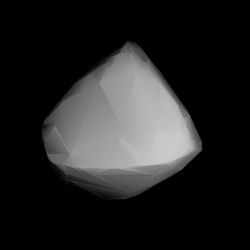astro.wikisort.org - Asteroid
5635 Cole (prov. designation: 1981 ER5) is a background asteroid from the inner regions of the asteroid belt, approximately 4 kilometers (2.5 miles) in diameter. It was discovered on 2 March 1981, by American astronomer Schelte Bus at the Siding Spring Observatory in Australia.[1] The L/S-type asteroid has a rotation period of 5.79 hours.[7] It was named after the fictional character Joshua Cole.[1]
 Shape model of Cole from its lightcurve | |
| Discovery [1] | |
|---|---|
| Discovered by | S. J. Bus |
| Discovery site | Siding Spring Obs. |
| Discovery date | 2 March 1981 |
| Designations | |
MPC designation | (5635) Cole |
Named after | Joshua Cole [1] (fictional character) |
Alternative designations | 1981 ER5 · 1986 XC5 1988 CO5 |
Minor planet category | main-belt [1][2] · (inner) background [3] |
| Orbital characteristics [2] | |
| Epoch 23 March 2018 (JD 2458200.5) | |
| Uncertainty parameter 0 | |
| Observation arc | 37.20 yr (13,588 d) |
| Aphelion | 3.0272 AU |
| Perihelion | 1.7431 AU |
Semi-major axis | 2.3851 AU |
| Eccentricity | 0.2692 |
Orbital period (sidereal) | 3.68 yr (1,345 d) |
Mean anomaly | 248.82° |
Mean motion | 0° 16m 3.36s / day |
| Inclination | 7.3102° |
Longitude of ascending node | 274.08° |
Argument of perihelion | 54.118° |
| Physical characteristics | |
Mean diameter | 3.51±0.80 km[4] 4.263±0.620 km[5][6] 4.71 km (calculated)[7] |
Synodic rotation period | 5.792±0.001 h[8] 5.7937±0.0001 h[9] |
Geometric albedo | 0.20 (assumed)[7] 0.29±0.14[4] 0.294±0.100[5][6] |
Spectral type | S (assumed)[7] LS (SDSS-MOC)[10] |
Absolute magnitude (H) | 13.8[6] 14.0[2][7] 14.33[4] |
Orbit and classification
Cole is a non-family asteroid of the main belt's background population when applying the hierarchical clustering method to its proper orbital elements.[3] It orbits the Sun in the inner main-belt at a distance of 1.7–3.0 AU once every 3 years and 8 months (1,345 days; semi-major axis of 2.39 AU). Its orbit has an eccentricity of 0.27 and an inclination of 7° with respect to the ecliptic.[2] The body's observation arc begins with a precovery taken at the discovering Siding Spring Observatory on 9 February 1981, or four weeks prior to its official discovery observation.[1]
Naming
This minor planet was named after fictional character Joshua Cole in the novel Cole of Spyglass Mountain (1923) by Arthur Preston Hankins. The protagonist, reminiscent of Oliver Twist, is an amateur astronomer in a dystopian society where boys receive numbers instead of names. In the novel, Cole's number is List of minor planets: 5001–6000#635 and corresponds to this asteroid's numbering.[1] The official naming citation was prepared by David H. Levy and published by the Minor Planet Center on 14 December 1997 (M.P.C. 31024).[11]
Physical characteristics
In the Moving Object Catalog of the Sloan Digital Sky Survey, Cole has a spectral type is closest to an L-type asteroid followed by the common, stony S-type.[10] The Collaborative Asteroid Lightcurve Link also assume it to be an S-type asteroid.[7]
Rotation period
In September 2004, two rotational lightcurves of Cole were obtained from photometric observations by Donald Pray, Silvano Casulli, René Roy. Lightcurve analysis gave a well-defined rotation period of 5.792 and 5.7937 hours with a brightness amplitude of 0.33 and 0.30 magnitude, respectively (U=3/3).[8][9]
Diameter and albedo
According to the survey carried out by the NEOWISE mission of NASA's Wide-field Infrared Survey Explorer, Cole measures between 3.51 and 4.263 kilometers in diameter and its surface has an albedo between 0.29 and 0.294,[4][5][6] while the Collaborative Asteroid Lightcurve Link assumes a standard albedo for a stony asteroids of 0.20, and calculates a diameter of 4.71 kilometers based on an absolute magnitude of 14.0.[7]
References
- "5635 Cole (1981 ER5)". Minor Planet Center. Retrieved 16 May 2018.
- "JPL Small-Body Database Browser: 5635 Cole (1981 ER5)" (2018-04-24 last obs.). Jet Propulsion Laboratory. Retrieved 16 May 2018.
- "Asteroid 5635 Cole". Small Bodies Data Ferret. Retrieved 15 May 2018.
- Nugent, C. R.; Mainzer, A.; Bauer, J.; Cutri, R. M.; Kramer, E. A.; Grav, T.; et al. (September 2016). "NEOWISE Reactivation Mission Year Two: Asteroid Diameters and Albedos". The Astronomical Journal. 152 (3): 12. arXiv:1606.08923. Bibcode:2016AJ....152...63N. doi:10.3847/0004-6256/152/3/63.
- Masiero, Joseph R.; Mainzer, A. K.; Grav, T.; Bauer, J. M.; Cutri, R. M.; Dailey, J.; et al. (November 2011). "Main Belt Asteroids with WISE/NEOWISE. I. Preliminary Albedos and Diameters". The Astrophysical Journal. 741 (2): 20. arXiv:1109.4096. Bibcode:2011ApJ...741...68M. doi:10.1088/0004-637X/741/2/68.
- Mainzer, A.; Grav, T.; Masiero, J.; Hand, E.; Bauer, J.; Tholen, D.; et al. (November 2011). "NEOWISE Studies of Spectrophotometrically Classified Asteroids: Preliminary Results". The Astrophysical Journal. 741 (2): 25. arXiv:1109.6407. Bibcode:2011ApJ...741...90M. doi:10.1088/0004-637X/741/2/90. (catalog)
- "LCDB Data for (5635) Cole". Asteroid Lightcurve Database (LCDB). Retrieved 16 May 2018.
- Pray, Donald P. (September 2005). "Lightcurve analysis of asteroids 106, 752, 847, 1057, 1630, 1670, 1927 1936, 2426, 2612, 2647, 4087, 5635, 5692, and 6235" (PDF). Minor Planet Bulletin. 32 (3): 48–51. Bibcode:2005MPBu...32...48P. ISSN 1052-8091. Retrieved 22 March 2020.
- Behrend, Raoul. "Asteroids and comets rotation curves – (5635) Cole". Geneva Observatory. Retrieved 16 May 2018.
- Carvano, J. M.; Hasselmann, P. H.; Lazzaro, D.; Mothé-Diniz, T. (February 2010). "SDSS-based taxonomic classification and orbital distribution of main belt asteroids". Astronomy and Astrophysics. 510: 12. Bibcode:2010A&A...510A..43C. doi:10.1051/0004-6361/200913322. Retrieved 30 October 2019. (PDS data set)
- "MPC/MPO/MPS Archive". Minor Planet Center. Retrieved 16 May 2018.
External links
- Lightcurve Database Query (LCDB), at www.minorplanet.info
- Dictionary of Minor Planet Names, Google books
- Asteroids and comets rotation curves, CdR – Geneva Observatory, Raoul Behrend
- Discovery Circumstances: Numbered Minor Planets (5001)-(10000) – Minor Planet Center
- 5635 Cole at AstDyS-2, Asteroids—Dynamic Site
- 5635 Cole at the JPL Small-Body Database
Другой контент может иметь иную лицензию. Перед использованием материалов сайта WikiSort.org внимательно изучите правила лицензирования конкретных элементов наполнения сайта.
WikiSort.org - проект по пересортировке и дополнению контента Википедии